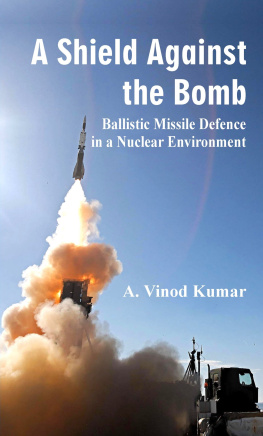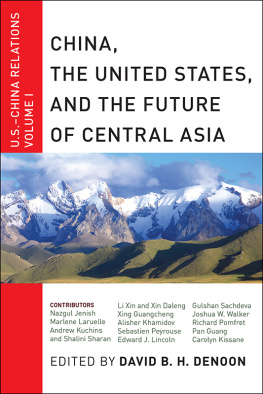David B H Denoon - Ballistic Missile Defense in the Post-Cold War Era
Here you can read online David B H Denoon - Ballistic Missile Defense in the Post-Cold War Era full text of the book (entire story) in english for free. Download pdf and epub, get meaning, cover and reviews about this ebook. year: 2021, publisher: Routledge, genre: Politics. Description of the work, (preface) as well as reviews are available. Best literature library LitArk.com created for fans of good reading and offers a wide selection of genres:
Romance novel
Science fiction
Adventure
Detective
Science
History
Home and family
Prose
Art
Politics
Computer
Non-fiction
Religion
Business
Children
Humor
Choose a favorite category and find really read worthwhile books. Enjoy immersion in the world of imagination, feel the emotions of the characters or learn something new for yourself, make an fascinating discovery.
- Book:Ballistic Missile Defense in the Post-Cold War Era
- Author:
- Publisher:Routledge
- Genre:
- Year:2021
- Rating:3 / 5
- Favourites:Add to favourites
- Your mark:
- 60
- 1
- 2
- 3
- 4
- 5
Ballistic Missile Defense in the Post-Cold War Era: summary, description and annotation
We offer to read an annotation, description, summary or preface (depends on what the author of the book "Ballistic Missile Defense in the Post-Cold War Era" wrote himself). If you haven't found the necessary information about the book — write in the comments, we will try to find it.
Ballistic Missile Defense in the Post-Cold War Era — read online for free the complete book (whole text) full work
Below is the text of the book, divided by pages. System saving the place of the last page read, allows you to conveniently read the book "Ballistic Missile Defense in the Post-Cold War Era" online for free, without having to search again every time where you left off. Put a bookmark, and you can go to the page where you finished reading at any time.
Font size:
Interval:
Bookmark:

605 Third Avenue, New York, NY 10017
2 Park Square, Milton Park, Abingdon, Oxon OX14 4RN
Product or corporate names may be trademarks or registered trademarks, and are used only for identification and explanation without intent to infringe.
Denoon, David.
Ballistic missile defense in the postCold War era / David B.H. Denoon.
p. cm.
Includes bibliographical references.
1. Ballistic missile defensesUnited States. 2. Antimissile
missilesUnited States. 3. World politics1989 I. Title.
UG743.D46 1995
358.1'74'0973dc20 95-12440
CIP
ISBN 13: 978-0-3671-6689-2 (pbk)
- 2 The Changing Meaning of Deterrence
- 3 Theater Missile Defense
- 4 The Legacy of SDI
- 5 National Missile Defense
- 6 Missile Defense and U.S. Security Policy
- 2 The Changing Meaning of Deterrence
- 3 Theater Missile Defense
- 4 The Legacy of SDI
- 5 National Missile Defense
- 6 Missile Defense and U.S. Security Policy
- Tables
- 3.1 Planned Ballistic Missile Production Ranges
- 3.2 Space Launch Vehicle Producers
- 3.3 Comparing High Explosive Warheads
- 3.4 Potential TMD Systems
- 3.5 TMD/NMD Program Options
- 4.1 Evolution of Space-Based Components
- 5.1 BMD for Defending Population vs. Enhancing Deterrence
- 5.2 Provisions of the Missile Defense Act of 1991
- 5.3 Comparison of Warhead Levels Before and After START I & II
- 5.4 Key Limited Systems Under START I & II
- 6.1 BMD as a Cost-Benefit Problem
- 6.2 Options for BMD Decisions
- 6.3 Present and Potential Future TMD Systems
- 6.4 Policy Changes to Supplement BMD
- Figures
- 3.1 TBM Range and Timing Characteristics
- 3.2 North Korea's Nuclear Program
- 3.3 Patterns of Falling Debris from Patriot Interceptors
- 3.4 Active Defense Geometry
- 3.5 Overlap Between Theater and Strategic Systems
- 3.6 Possible Mid-Term TMD System Architecture
- 4.1 Fletcher Report: Phases of Ballistic Missile Trajectories
- 4.2 Fletcher Report: Preliminary Concept for Ballistic Missile Defense During the Boost Phase
- 4.3 Example of Non-Nuclear Ground and Space-Based Architecture
- 4.4 Space Defense System Acquisition Cost
- 4.5 Phase I Architecture with Brilliant Pebbles
- 5.1 Preferred Presidential Policies: Offense vs. Defense
- 5.2 Changes in System Acquisition Cost
Font size:
Interval:
Bookmark:
Similar books «Ballistic Missile Defense in the Post-Cold War Era»
Look at similar books to Ballistic Missile Defense in the Post-Cold War Era. We have selected literature similar in name and meaning in the hope of providing readers with more options to find new, interesting, not yet read works.
Discussion, reviews of the book Ballistic Missile Defense in the Post-Cold War Era and just readers' own opinions. Leave your comments, write what you think about the work, its meaning or the main characters. Specify what exactly you liked and what you didn't like, and why you think so.











